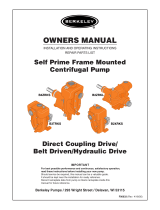
FM USER INSTRUCTIONS ENGLISH 71576526- 03/07
Page 4 of 32 flowserve.com
1 INTRODUCTION AND SAFETY
1.1 General
These instructions must always be kept
close to the product's operating location or
directly with the product.
Flowserve products are designed, developed and
manufactured with state-of-the-art technologies in
modern facilities. The unit is produced with great
care and commitment to continuous quality control,
utilizing sophisticated quality techniques, and safety
requirements.
Flowserve is committed to continuous quality
improvement and being at service for any further
information about the product in its installation and
operation or about its support products, repair and
diagnostic services.
These instructions are intended to facilitate
familiarization with the product and its permitted use.
Operating the product in compliance with these
instructions is important to help ensure reliability in
service and avoid risks. The instructions may not
take into account local regulations; ensure such
regulations are observed by all, including those
installing the product. Always coordinate repair
activity with operations personnel, and follow all
plant safety requirements and applicable safety and
health laws and regulations.
These instructions must be read prior to
installing, operating, using and maintaining the
equipment in any region worldwide. The
equipment must not be put into service until all
the conditions relating to safety noted in the
instructions, have been met.
1.2 CE marking and approvals
It is a legal requirement that machinery and
equipment put into service within certain regions of
the world shall conform with the applicable CE
Marking Directives covering Machinery and, where
applicable, Low Voltage Equipment, Electromagnetic
Compatibility (EMC), Pressure Equipment Directive
(PED) and Equipment for Potentially Explosive
Atmospheres (ATEX).
Where applicable the Directives andanyadditional
Approvals cover importantsafety aspects relating to
machinery andequipment andthe satisfactory
provision of technical documents andsafety
instructions.Where applicable this document
incorporatesinformationrelevantto these Directives
and Approvals.
To confirmthe Approvalsapplyingandif the product is
CE marked,checktheserial number plate markings
andthe Certification. (Seesection 9, Certification.)
1.3 Disclaimer
Information in these User Instructions is believed
to be reliable. In spite of allthe efforts of Flowserve
Corporation to providesound and all necessary
information the content of thismanualmayappear
insufficient and is notguaranteed by Flowserveas
to its completeness or accuracy.
Flowserve manufactures products to exacting
International Quality Management System Standards
as certifiedand audited by externalQuality Assurance
organizations. Genuine parts andaccessories have
beendesigned,tested andincorporatedinto the
products to help ensure theircontinuedproduct quality
and performance inuse. As Flowserve cannot test
parts andaccessories sourcedfromothervendors the
incorrect incorporationofsuch partsandaccessories
may adversely affect the performanceandsafety
features of the products. The failureto properlyselect,
installor use authorized Flowserve parts and
accessories is considered to be misuse. Damageor
failurecaused by misuse is notcovered by the
Flowserve warranty.Inaddition,any modificationof
Flowserve products or removaloforiginalcomponents
may impairthesafety of these products in their use.
1.4 Copyright
All rights reserved. No part of these instructions may
be reproduced, stored in a retrievalsystem or
transmitted in any form or by any means without
prior permission of Flowserve.
1.5 Duty conditions
This product has been selected to meet the
specifications of your purchaser order. The
acknowledgement of these conditions has been sent
separately to the Purchaser. Acopy should be kept
with these instructions.
The product must not be operated beyond
the parameters specified for the application. If
there is any doubt as to the suitability of the
product for the application intended, contact
Flowserve for advice, quoting the serial number.
If the conditions of service on your purchase order
are going to be changed (for example liquid pumped,
temperature or duty) it is requested that the user
seeks the written agreement of Flowserve before
start up.




















